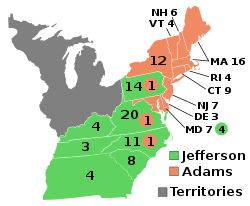November 4 – December 7, 1796 | |||||||||||||||||||||||
| |||||||||||||||||||||||
 County results
| |||||||||||||||||||||||
| |||||||||||||||||||||||
| Elections in Virginia |
|---|
 |
The 1796 United States presidential election in Virginia took place as part of the 1796 United States presidential election. Voters chose 21 representatives, or electors to the Electoral College, [1] who voted for President and Vice President.
Contents
Virginia voted for the Democratic-Republican candidate and Virginia native, Thomas Jefferson, over the Federalist candidate, John Adams. Jefferson won Virginia by a margin of 36.72%. Virginia chose electors by popular vote per electoral district and as such granted 1 electoral vote to John Adams.
Prior to the 12th Amendment, electors cast two votes, making no distinction if they were voting for Vice President or President, as such: Thomas Pinckney received 1 electoral vote, Aaron Burr received 1 electoral vote, Samuel Adams received 15 electoral votes, George Clinton received 3 electoral votes and George Washington received 1 electoral vote. It was well-known in 1796 that Jefferson and Adams were intended to be elected as president and Burr and Pinckney for vice president.


